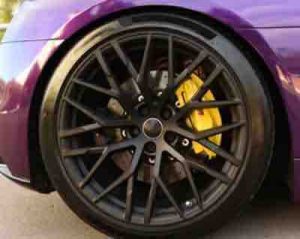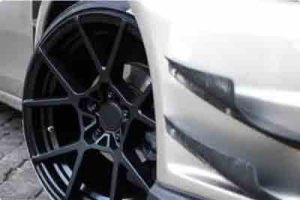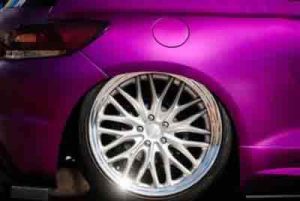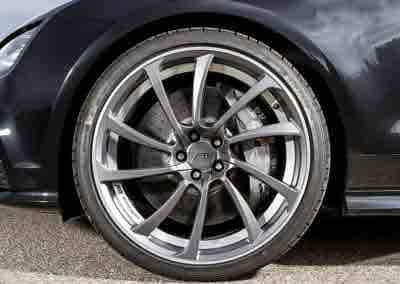Yes, low-profile tires wear out faster. This is because of the peculiar design of low-profile tires. It’s all in the tread design and the rubber compounds.
Low-profile tires have more effective tread because they are usually racing tires that need more traction. The tire compounds are also unlike traditional tires in that they are softer, and thus stick to the pavement better than conventional tires.
For these reasons, the tires wear out faster. Sports cars drivers have to drive these tires hard and fast, around corners making the treads wear faster.
If you have low-profile tires on your car, you are more likely to speed with it because that’s what they are suited for.
Table of Contents
How long do low-profile tires last?
On average usage, low-profile tires can last 6 years.
Low-profile tires last as long as other tires. The term low profile does not refer to the tread but to the height of the sidewall.
Tires have expiry dates, and their wear rate is written on the sidewall. You can find written on your tire, treadwear 300 or 580. The higher the number of treadwear, the longer the tire would last.
Other factors contribute to the lifespan of a low-profile tire. There is the rate you use the tire, the terrain where you drive it. As I have said already, the compound of the rubber also impacts how it wears.
If your tire is used for racing, expect to change your low-profile tire before the expiration of 6 years. However, if your tire is for suburban use alone, it is possible to enjoy its utility for up to 10 years.
Generally, low profile tires would have lower treadwear numbers which mean the manufacturer expects that you will be riding that tire hard.
How to take care of low profile tires

Tires bear the weight of your vehicle, which is an enormous weight if you ask me. Although they are built tough and designed to bear this weight and the hazard of both rough and smooth terrain, you still have to put some effort into taking care of your tires.
You can save yourself unnecessary expenses and hassle if you follow the tips below for your low-profile tire maintenance.
Aim for smoother roads in the city
Because low-profile tires are designed using softer compounds, they are more susceptible to damage. To protect them, map out your itinerary if you can, to connect with smooth roads in the city. Doing this protects the tread making it last longer.
Avoid potholes
Perhaps the most talked-about nemesis of the low-profile tire is a pothole. Because the sidewall of a low-profile tire is smaller than other tires, the wheel is always in danger during pothole season.
If your city or area is rife with potholes, then your tire is in grave danger. High-profile tires are better responsive to potholes.
Avoid high speeds
Folks who drive with low-profile tires often gush about how sleek their driving becomes. This is so true, low-profile tires feel good. You’d feel the urge to increase your speed on the highway, to milk this feel-good aura of driving a low-profile tire.
But if you want your tires to last long, then avoid excessive speeding as this wears out the tread faster. Minimize speeding on rough roads.
Avoid driving around corners too fast
Low-profile tires are great with handling corners on account of their flatter surface area, and greater traction. This translates to more wear on the tire’s tread.
Don’t always aim to drive around corners as fast as you can as this can not only be dangerous for you but also tells on your tire, reducing its lifespan.
Exceeding load capacity
You care for your low-profile tire by taking precautions against packing your car beyond the load rating. Of course, tires are designed to bear load, but stretching it on your low-profile tire will only wear it out faster.
It is worse if you exceed the load rating for your tire and drive through bumpy roads and into potholes repeatedly.
Complement your low profile tire with your car system
If you are changing from a conventional tire to a low-profile tire, you have to adjust your vehicle’s suspension to complement the tires. This also affects your wheel size as well.
The suspension and wheel size of your vehicle must be modified in order to improve the durability of your tires, thereby prolonging the lifespan.
Proper inflation
Although this applies to all tires, low profile tires are quicker to show over inflation and under-inflation.
Because they have a wider tread surface and lower sidewall, an under-inflated low-profile tire wears more near the sidewalls. Because the sidewall is lower too, this underinflation can result in pinch flats.
Avoid incorrect wheel alignment
Improper alignment is more quickly to affect low profile tires for the same reason that folks love them most, the low sidewall. When the wheel is improperly aligned the tire wears along the outside edge of the front tires.
This uneven wear is more pronounced for low-profile tires. If you have one on your car you should be concerned about the last time you hit the side of the curb or hit a pothole side straight on.
A skewed alignment will cause a situation where you have to change a front low profile tire repeatedly.
How to identify low-profile tires

How do you know a tire is low profile tire? As I have established already, the word low profile does not refer to quality per se, nor does it refer to tread. It refers to the size of the sidewall.
However, as you may have noticed not all sidewalls have the same height. Some are taller than others, so how do you determine while making a purchase, that you are about to buy an actual low-profile tire?
Let’s consider a few facts about low-profile tires that identify them.
- Low profile tires generally have stiffer and shorter sidewalls
- You can also tell a low-profile tire from the information provided on the sidewall
- Wider contact surface or patch
- Bigger wheels
- They look great on cars
Low profile tires generally have stiffer and shorter sidewalls
They are wider than conventional tires. Check the tire for this shortness in the sidewall, then try to pinch it with your fingers and feel how tough it feels.
You can also tell a low-profile tire from the information provided on the sidewall
There’s a numerical code on the side of every tire that helps buyers make the best decision about purchases. For example, you would see a set of codes like 195/70 R 15 C.
The number 70 indicates the aspect ratio of the tire. Here it means the height of the sidewall is 70 percent of the width of the tire.
Generally, if the aspect ratio of the tire is below 50 or 55, then the tire is considered a low-profile tire. Check your tire right now and see for yourself I’d this is so.
The truth of the matter is, low profile tires have a striking look that you can’t miss. Hence if your tires are low profile, you’d know they aren’t like normal tires.
Wider contact surface or patch
Does the tire look wider on the side that meets the pavement? Does this wideness look a little inordinate? Then you’re looking at a low-profile tire.
This is so as they are mostly designed for performance, which means they are made for speed and high traction.
Bigger wheels
Because low-profile tires have thinner sidewalls they are usually fitted on bigger wheels. And this makes sense since bigger wheels complement the tire for better braking power, acceleration, general handling, and better traction.
Have you noticed these wheels on sports cars with tires that balloon out of the sides of the cars? Have you also noticed how these cars are able to negotiate corners at high speeds? That is because of the beauties called low profile tires.
They look great on cars
If you’re looking to stand out in the crowd or you want to up your street cred, a low-profile tire can get you that. They give your car a distinct, sports car look even if your vehicle is not one of those.
Changing to low-profile tires requires that your car goes through a lot of modifications though, from the suspension system to the wheels.
Some who have made such arbitrary changes have had to deal with a situation where the tires are too big for the tire groove of their car.
The last one – you are in a car and every time the car hits a pothole or bump, no matter how small, you feel it where you are sitting in the back of the car.
You consider this unusual because perhaps the car is a BMW, a great car. Well, wonder no more. Check the tires and you’ll find they are low-profile tires.
Because the sidewalls are thinner, manufacturers reinforce it with harder materials to withstand the barrage of the terrain, this is why you’d feel every impact on the tire.
Are low-profile tires bad in rainy conditions?

Yes. Low-profile tires don’t do quite well in the rain.
The principle is that the wider the tire, the more likely it hydroplanes. This means gliding over the water rather than cutting through.
There are low-profile tires for all-season however with treads designed to spread the water out of the way as you drive. You’d have to be specific with your retailer about this function when buying a low-profile tire.
Low-profile tires do have excellent grip capabilities on dry pavement. But other than the high performance it allows when driving, one has to be careful on the wet road.
As hinted above, the tread pattern also plays a key role in whether the tire will do badly in rainy conditions or not. Some tread patterns channel water out of the path of tires more effectively than others.
If the low-profile tire has a tread pattern that channels water out of the way properly, it will do well in the rain. Another factor is how fast the car is going in the rain. The higher the speed, the more likely the car is to become water-borne.
Are low-profile tires bad in the snow?
Low-profile tires handle like most other tires on snow.
There really isn’t much difference other than the fact that low profile tires have more surface grip than high profile tires, consequently, they do better on snow.
However many users who live where it snows and who use low profile tires have said these tires do poorly. Perhaps these users expected low profile to perform as well as snow tires which are specifically designed for snowy conditions.
All-season tires do better in the snow because they are designed to provide traction in all seasons. They have deep treading and compounds that maintain their flexibility in all weathers, hot, cold, and snow.
If the low profile tires have deep grooves, large blocks of it with wide spaces between them which increases traction in snow, it is like an all-season tire.
Are low-profile tires better for racing?
Race cars don’t use low-profile tires.
Racing organizations have very different rules when it comes to tires. We may be able to attempt however a guess as to why race cars don’t use low profile tires.
Low-profile tires have low flex because the sidewalls are so short and hard. Hence when they make for harder driving, something that I don’t think a race car driver benefits from since he’s trying to go as fast as possible to win a race.
Moreover, race cars have to drive so hard and fast that they would end up wearing out their tires in a short time. In my estimation, low profile tires with their soft rubber are not economical for races for this reason.
Racecar tires are called slicks before they don’t have as much tread as normal tires.
Related:
- Signs That Your Vehicle Need a New Tire
- How Far Can You Drive on a Car Tire with a Slow Leak
- How Long Does a Slashed Tire Take to Deflate
- Brand New Tire Losing Air Pressure: 9 things to do

